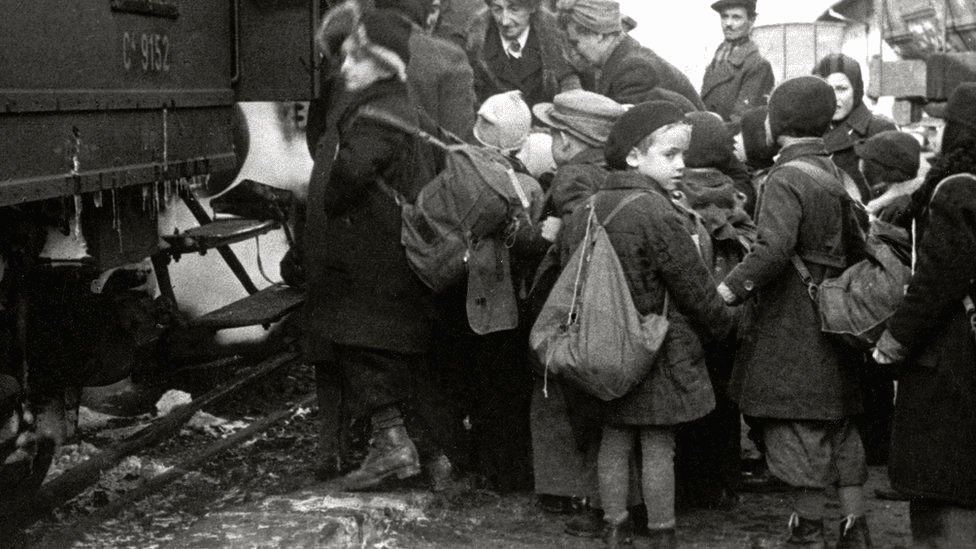Kindertransport: When England Tried To Save Jewish Children
Between 1938 and 1940, Britain rescued 10,000 mostly Jewish children from Nazi Europe—but not their parents. Behind the celebrated humanitarian mission lay eugenic selection criteria, traumatic separations, and reunions broken beyond repair. The Kindertransport saved lives at a profound cost.

The train station platforms across Germany, Austria, and Czechoslovakia witnessed scenes of quiet devastation in late 1938 and throughout 1939. Parents checked their children's clothing one final time. They straightened collars, adjusted identity tags, and pressed small suitcases into small hands. Then came the goodbyes: measured, controlled, desperately cheerful.
"There was laughter and crying and one last hug," recalled social worker Norbert Wollheim, who organised many of these departures. The children walked towards waiting trains. Their parents stayed behind. For most, this would be the last time they ever saw each other.
The Night Everything Changed
9 November 1938. Across the German Reich, synagogues burned. Glass from Jewish shop windows carpeted the streets—so much glass the night would forever be known as Kristallnacht, the Night of Broken Glass. Nazi SA paramilitary forces and ordinary German citizens destroyed 267 synagogues, murdered 91 Jews, and arrested 30,000 people who were then sent to concentration camps.
The violence shocked the world. Newspapers in Britain published photographs and eyewitness accounts. Public outrage mounted. Something had to be done.
Twelve days later, Parliament convened to debate the refugee crisis. The discussion, held on 21 November, faced an uncomfortable reality: Britain had just imposed new restrictions on Jewish immigration to Palestine, where it held a mandate. The country had shown little appetite for accepting adult refugees. At the Évian Conference earlier in 1938, nations including Britain and the United States had failed to reach agreement about accepting Jews fleeing Nazi Germany.
Yet the images from Kristallnacht demanded action. The British government found a solution: admit the children, but not their parents.
Home Secretary Sir Samuel Hoare authorised the programme. Visa requirements would be waived for unaccompanied minors under seventeen years of age. No numerical limit would be set. One catch: the British government would provide no financial support whatsoever. Private citizens, charities, and volunteer organisations would need to foot the entire bill.
For each child, a £50 bond had to be posted to "assure their ultimate resettlement." The assumption was simple: this would be temporary. Once the crisis passed, the children would reconnect with their parents. Nobody imagined what was coming.
The Machinery of Rescue
Within weeks, a complex operation sprang to life. In Germany, the Reich Representation of Jews coordinated the transports from Berlin. In Vienna, the Jewish Community Organisation handled the arrangements. From Prague, other groups mobilised after Germany dismantled Czechoslovakia in March 1939.
The organisers prioritised desperately: children whose parents were in concentration camps, orphans, those whose families could no longer support them. Jewish communities scrambled to compile lists.
In Britain, the refugee children's committee, an interdenominational umbrella organisation staffed largely by volunteers, worked to place children with foster families. Advertisements appeared in newspapers, particularly the Jewish Chronicle. "Please help me bring out of Berlin two children (boy and girl), ten years, best family, urgent case," read one typical appeal.
The first transport left Berlin on 1 December 1938. Florence Nankivell, a British organiser, had spent a week in Berlin facing harassment from Nazi police. She assembled 196 children, most from a Jewish orphanage burned during Kristallnacht. The train crossed into the Netherlands, then the children boarded a ferry to Harwich, arriving on 2 December.
The second major transport departed Vienna on 10 December with 600 children. Geertruida Wijsmuller-Meijer, a Dutch volunteer who had organised refugee rescues since 1933, negotiated directly with Adolf Eichmann. She persevered through initial rejections until Eichmann suddenly "gave" her 600 children—seemingly attempting to overwhelm her with an impossible task. She succeeded anyway.
More trains followed from Vienna, Berlin, Prague, Hamburg, and other cities. Children from smaller towns travelled to these collection points to join the transports. Trains crossed through Belgium and the Netherlands before the ferry crossing to England.
The programme continued until the outbreak of war. The last transport from Germany left on 1 September 1939—the day German forces invaded Poland. The last from the Netherlands departed on 14 May 1940, the same day the Dutch army surrendered to German forces. By then, approximately 10,000 children had reached Britain.
The Selection Nobody Discusses
Behind the success story lay uncomfortable truths about who was chosen and who was left behind.
The refugee children's committee tried to admit only children without special needs or health issues. Financial and organisational pressures led to a selection process favouring the healthy and able-bodied. Applications mentioning any illnesses or additional needs faced rejection. Even children whose parents had mental health problems were turned away.
Correspondence between organisers reveals eugenic and antisemitic views influenced some decisions. One applicant, Kitty Milch, was described as "an intelligent looking and not particularly Jewish" girl—the implication being her appearance made her more acceptable.
Herta Baumfeld, born 26 April 1926, was rejected because her mother was in a psychiatric institution. By 1938, many youngsters had lived for years under stressful conditions of discrimination and persecution. Yet the very children most affected by Nazi terror often found themselves excluded from rescue.
This seems especially cruel given Britain's stated humanitarian purpose. The decision reflected contemporary attitudes about "physical and mental fitness" rooted in eugenic thinking widespread across Britain, America, and Scandinavia during the 1930s and 1940s. Children considered "defective" were deemed unsuitable even for a rescue mission.
The Impossible Choice
For Jewish parents across the Reich, the Kindertransport presented an agonising dilemma. Send your child—perhaps as young as two years old—to live with strangers in a foreign country? Or keep your family together and face whatever came next?
In 1933, when the League of Jewish Women had discussed unaccompanied child emigration, the consensus held such separation was not desirable. But 1933 was before the full horror revealed itself. By late 1938, Jewish citizens confronted the reality of Nazi persecution. The violence of Kristallnacht made clear what might follow. Families considered any means of escape, even splitting children from parents.
Home Secretary Hoare himself acknowledged the terrible calculus:
I could not help thinking what a terrible dilemma it was to the Jewish parents in Germany to have to choose between sending their children to a foreign country, into the unknown, and continuing to live in the terrible conditions to which they are now reduced in Germany.
Yet Britain had excluded the parents from the rescue.
Several theories explain why the government restricted the visa waiver scheme to children only. The decision clearly limited eligible numbers. Children were unlikely to enter the labour market immediately, allaying fears about foreign competition for British workers during a time of high unemployment. Press reports from the 1930s also expressed fears of dangerous adult individuals disguising themselves as refugees, whilst Kindertransportees could be portrayed as young and innocent.
Some parents refused to make the choice. Families decided separation was not a solution and did not put their children forward. Bob Kirk, who fled from northern Germany aged 13, reflected later:
I felt tremendous gratitude to my parents for their courage. All the parents who allowed their children to go showed tremendous courage.
The Journey and After
The train ride itself traumatised many children. On the way over the German-Dutch border, SS members boarded and pawed through carefully packed clothes and toys. Children wept and shrieked in terror.
For some older children, leaving felt like relief. Others saw their flight as an adventure. For many smaller children, especially those under five, the experience was bewildering and frightening. Nine-year-old Martha Immerdauer from Vienna recalled:
When my parents broke this news to me, I was devastated and burst into hysterical sobs at the mere thought... I felt as though some force stronger than myself was dragging me into an abyss and I had no power to prevent it.
Vetting of foster families was lenient when it happened at all. Some children entered homes where they were cherished and cared for as family. Others faced abuse or were expected to work as unpaid servants. Still others found themselves with well-meaning families who provided for physical needs but offered no affection or nurturing.
Language barriers complicated everything: children attended British schools speaking little or no English. Some families were kind but distant. Some foster parents struggled to understand their young charges—why did these children refuse food even when obviously hungry? Why did they go to sleep with the light on Friday night?
The outbreak of war in September 1939 closed borders permanently. Children received occasional letters from parents through the Red Cross. As the war progressed, letters became sparse, arriving after months of silence, then dwindling to brief and rare messages. Eventually, for most, the letters stopped coming altogether.
In May 1940, Britain implemented a policy of internment for "enemy aliens." This affected older Kindertransport children who had reached sixteen. Some found themselves briefly detained despite being refugees from Nazi persecution. The contradiction was painful: saved from the Nazis, then treated as potential Nazi agents.
The Reckoning
When the war ended in 1945, agencies were flooded with requests from children seeking to find their parents or any surviving family member. The statistics remain frustratingly imprecise, but recent estimates suggest only about half of the 10,000 children ever saw one or both parents again.
The majority discovered their parents had been murdered in the Holocaust. Mothers and fathers deported to Auschwitz, Treblinka, ghettos across Poland. Some children received final telegrams from fathers about mothers' deportations, expressing hope to reunite after the war. Weeks later, the fathers were deported too.
For these children, learning their parents' fates brought unbearable grief—made worse by a culture of imposed gratitude. "We were saved, how dare we criticise anything?" one Kind wrote in her autobiography years later.
For those fortunate enough to reunite with surviving parents, joy was often complicated by profound difficulties. Many years had elapsed. The children and parents had lost their emotional bonds and common cultural and linguistic backgrounds. Children had grown up British. Parents were strangers speaking a foreign language.
Trude Silber arrived in Sweden on a Kindertransport from Austria aged eight. Her foster family provided for her physical needs but showed no affection. Too young to comprehend why her parents had sent her away, she did not experience it as an act of love. When she reunited with her parents in Palestine after the war, Trude carried pain and resentment. The reunion was far from joyous. It was uncomfortable and contentious.
The nightmares persisted for decades. Hans Wiener, who escaped Germany aged fourteen, reported a recurring dream where he held his mother's hand, then their grip slipped and suddenly he was alone.
Another survivor recalled:
The last thing I remember consciously is my parents waving goodbye to us as the train pulled away from the platform. My mum was crying.
The Legacy Question
Today, politicians and media frequently invoke the Kindertransport as evidence of Britain's "proud tradition" of taking in refugees. Bronze statues at railway stations commemorate the arriving children. The programme is held up as an example of humanitarian action during dark times.
But historians now urge a more complicated reckoning. The Kindertransport was indeed a visa waiver scheme initiated by the government—but financial and organisational support came entirely from private charities and volunteers. Britain admitted children whilst excluding their families and maintaining strict restrictions on adult refugees.
Around 80,000 refugees successfully entered Britain between 1933 and 1939 out of approximately 500,000 to 600,000 who tried. The Kindertransport children were among the fortunate 10,000. Hundreds of thousands of others found no refuge.
In the United States, the Wagner-Rogers Bill proposed bringing 20,000 refugee children to America. Congress did not pass it.
Some families who were not allowed to send their children on the Kindertransport perished together. Would they have been better served by a policy accepting entire families? The question haunts the programme's legacy.
Professor Jessica Reinisch argues the Kindertransport model is taken out of context and subject to nostalgia when used in contemporary refugee debates. The scheme emerged from specific historical circumstances. At the Évian Conference in 1938, Britain and the United States did much to prevent immigration, turning desperate people away. The limited child rescue came only after Kristallnacht made inaction politically impossible.
The separation itself was controversial even at the time. British politicians in November 1938 debates knew the trauma children and parents would experience. They chose to proceed with a policy allowing only children rather than families. Political and economic considerations—preventing adult refugees from competing for British jobs, limiting financial burden on the state—shaped this choice more than pure humanitarian concern.
The Price of Rescue
Ten thousand children survived. This is not a small number. Each life saved mattered immensely—to the children themselves, to their descendants, to the world. Many became distinguished scientists, artists, writers, and citizens. They contributed enormously to British society and beyond.
Yet the price was staggering. Childhood ended on railway platforms across Europe. Years passed in homes where children were wanted or unwanted, loved or merely tolerated, cherished or exploited. The majority grew up orphaned, carrying grief and trauma they often felt unable to express because gratitude was demanded of them.
Even reunited families often broke beyond repair. Parents and children had become strangers, separated by years, languages, and unbridgeable experiences.
The Kindertransport cannot be understood simply as a rescue success or as a failure. It was both simultaneously—a desperate measure during desperate times, saving lives whilst inflicting profound costs on survivors and their families. It reflected genuine humanitarian impulses mixed with political calculations, extraordinary individual courage alongside systemic exclusions, and tremendous achievement shadowed by enormous loss.
The children who boarded those trains in 1938 and 1939 paid with their childhoods for the chance to live. Their parents paid with their lives for their children's survival. Neither should be forgotten. Neither the rescue nor its cost.




